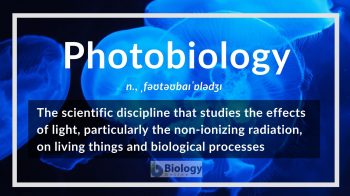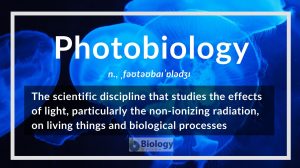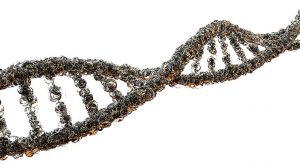
Photobiology definition:
n., ˌfəʊtəʊbaɪˈɒlədʒɪ
The scientific discipline that studies the effects of light, particularly the non-ionizing radiation, on living things and biological processes
Table of Contents
Photobiology Definition
Photobiology, the biology of light, is a subdiscipline in biology. It focuses on the effects of light, particularly, the non-ionizing radiation, on organisms and biological processes.
Subdisciplines of Photobiology
Photobiology has different specialty areas. One of them is photophysics that deals primarily with the physical interactions of light and matter that result in structural changes at the molecular and atomic levels. Another specialty is photochemistry that studies molecular reaction following photon absorption. (Ref.1)
Photobiology Research Topics
Photobiology is concerned with the beneficial and the detrimental effects of light on living things. Below are some of the common topics for photobiology research where one of its aims is to understand the various natural phenomena where light plays a key role. It is also geared towards finding its valuable use in medicine.
Photosynthesis
Light is one of the most essential physical factors that affect living things. Photoautotrophs, for instance, rely on light energy to fuel the initial stages of photosynthesis as they synthesize sugar molecules. Photons from solar energy, for instance, are harvested by photosystems located in the thylakoids. The photon that is absorbed is passed on from one pigment molecule to another until it reaches the reaction center (containing chlorophyll a). The photon, then, fuels a redox reaction in the reaction center. This excites the electron from the pigment molecule (chlorophyll a) in the reaction center and eventually gets transferred to a special molecule called “primary acceptor”. As the name implies, this molecule accepts the electron from the reaction center of the photosystem. From the primary acceptor, the electron moves in a series of redox reactions along the electron transport chain (ETC). This electron flow in the ETC provides the energy for the chemiosmotic synthesis of ATP. This occurs in the reaction center of Photosystem II (P680). In Photosystem I (P700), the photon that is absorbed results similarly in electron excitability, redox reaction, and electron transfer to the primary acceptor. However, the process could lead to another pathway wherein another type of energy-carrying molecule, NADPH, is supplied.
Phototropism
Phototropism is a form of tropism where an organism responds to a light stimulus. The response may either be a growth toward (positive) or away (negative) from the light source. Plants exhibit phototropism. Their shoots grow toward the light to maximize photon absorption that is crucial to sugar biosynthesis. The light acts on auxin (a plant hormone) that promotes localized cell elongation to enable the growing shoots to bend towards the light. While the shoots grow toward the light, the roots grow away from the light. Apart from gravity, light also has an effect on root growth. This is to ensure that root growth is properly oriented towards the soil. In particular, the blue or white light induces negative phototropism whereas the red light induces positive phototropism in roots. (Ref.2)
Diurnal rhythms
Biological rhythms that are synchronized to day and night is called a diurnal rhythm. The rhythmic pattern is driven by a biological clock. Certain physiological processes and animal behavior exhibit patterns typical of a diurnal rhythm. For example, the microfilariae of loa loa are released into the peripheral blood predominantly at daytime. Animals that are active at night are described as nocturnal whereas those that are active during the day are described as diurnal.
Bioluminescence
Bioluminescence is the emission of light of an organism. Examples of organisms that emit light are fireflies, Aequorea victoria (a jellyfish species), firefly squid, dinoflagellates, and certain fungi (e.g. honey fungus). The biochemical reaction that ends in the emission of light entails the enzyme luciferase or photoprotein and the luciferin. The enzyme catalyzes the oxidation of a luciferin substrate. This causes the latter to be in an electronically excited state and the way to go back to its ground state is to release a photon of light. Some bioluminescent organisms produce their own enzyme whereas others absorb it through symbiosis with other organisms. (Ref. 3) For example, squid forms symbiotic relationship with bioluminescent bacteria and as such apparently exhibiting bioluminescence.
Skin pigmentation
Skin pigmentation is another manifestation of light regulatory effects. In humans, the skin contains melanin pigments that are produced by melanocytes. The cells produce them through the oxidation of tyrosine followed by polymerization. The extent of melanin production is influenced by light exposure. The skin produces more melanin as a defense mechanism against the detrimental effects of prolonged sun exposure.
Photomedicine
A special application of photobiology is photomedicine. Using a photosensitizing drug, cells can be targeted to induce cell death. This is particularly useful in treating tumors and cancer cells. This therapeutic modality using photons is called photodynamic therapy.
The therapeutic advantage of light has a long history that dates back in ancient times. Apparently, the beneficial effects of light on health rely on the type of light source. Not only humans are sensitive to light. All organisms, from the single-celled bacteria, algae, and protists to the multicellular plants, fungi, and animals, are photo-biologically susceptible. Animal behavior (diurnal and nocturnal), for instance, will depend according to the presence of light. Thus, in wildlife, regulating artificial lighting is essential to hinder the effects of “light pollution”. (Ref. 4) Electrical lighting has to be designed in a way that the potential unnecessary and unpleasant effects of artificial lighting can be prevented to “leak” in the wild. (Read: Electric Light Factsheet: Options & Health Impacts)
See also
References
- What is Photobiology? (2012). Photobiology.Info. http://photobiology.info/introduction.html
- Kiss, J. Z., Correll, M. J., Mullen, J. L., Hangarter, R. P., & Edelmann, R. E. (2003). Root phototropism: how light and gravity interact in shaping plant form. Gravitational and Space Biology Bulletin : Publication of the American Society for Gravitational and Space Biology, 16(2), 55–60. https://www.ncbi.nlm.nih.gov/pubmed/12959132
- National Geographic Society. (2013, June 13). bioluminescence. National Geographic Society. https://www.nationalgeographic.org/encyclopedia/bioluminescence/
- Electric Light Factsheet: Options & Health Impacts. (2019, October 8). Building Biology Institute. https://buildingbiologyinstitute.org/free-fact-sheets/electric-light/
©BiologyOnline. Content provided and moderated by BiologyOnline Editors.







